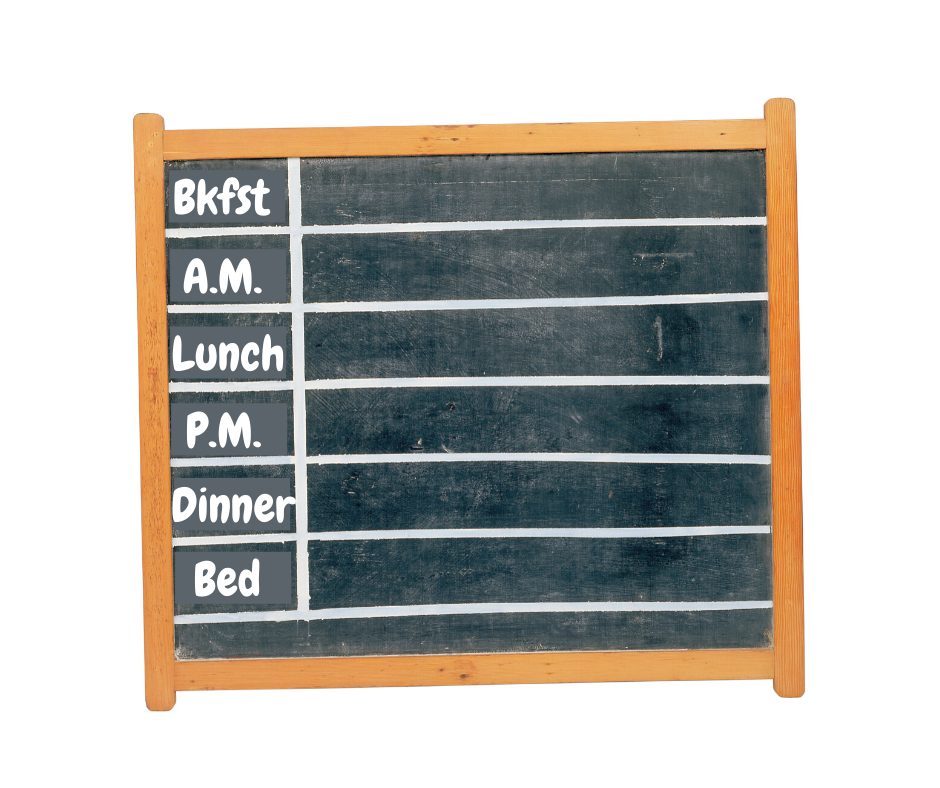
by Gabrielle Hillman, B.A., Graduate Intern
Changes in schedules can be overwhelming and scary. Routines allow for clear expectations and create consistency of what needs to be done and how it must be done daily. Even small changes in our routine can be extremely hard and may throw off our sense of normalcy. So, whether it is a global pandemic or the closing of your favorite coffee shop, when things change, we feel a bit off balance.
Children need routines more than most. Having a routine helps to keep them on schedule and sets clear expectations of what is to come. Changes in their daily lives may impact them more intensely considering they may not have the same understanding of what is going on in the world around them. Kids who have special needs may also feel the impact of a change in routine. Without knowing how to process changes, behavior patterns may shift and leave the whole family feeling overwhelmed.
Change is hard and can result in big emotions. It is important to focus on what you can control during these times. Here are some tips to regain structure throughout changing and uncertain times.
Kids Need Structure
Children will carry these foundational skills with them for the rest of their life. Structure is critical to building time management skills, confidence, self-discipline, and many other aspects of life. Structure also provides a sense of predictability and control for a child. Before the age of 5, kids rely heavily on their parents and caregivers to help them build their foundational skills. This stage of development is critical, so it is important to instill positive behaviors early on.
Change Can be Hard
There is comfort in knowing what is going to happen next. The vagueness of uncertainty raises our stress with the idea of not knowing what will happen next and not knowing how to prepare. For some, their adaptability and flexibility skills allow them to transition through these times with ease. For most, there is a learning curve, a stage of transition that requires some work. For kids, and especially kids with special needs, transition and change throws off their equilibrium. There are many factors that may impact this but, when it comes down to it, it all depends on your child’s needs, temperament and their capabilities.
Patience — Trust in the Process!
Although your ‘normal schedule’ is changing, remember that at one time, that schedule was new as well. Adjusting to change takes time. It is normal to initially feel overwhelmed or scared. If possible, try to make smaller changes to help transition. If that is not an option, try to keep the general overall schedule and make small adjustments according to the new situation.
Just because change has been difficult in the past doesn’t mean it will always be difficult. Once you establish clear coping mechanisms you will have a better grasp on how to navigate this difficult time. Essentially, establishing a “routine in the absence of a routine” ensures that even when things start to shift, you have a general structure and plan to ease the transition.
Tips: How To Create Structure During Unstructured Times
For You and Your Kids

- Try creating a visual schedule of your day. Use a poster board with visual aids to guide you through the day. If you will be out of the house, take a photo so you can refer back to it if needed.
- Schedule some flexibility into your schedule. Keep the topics broad and vague, so if there is a need to switch things up, there is room to still be flexible but keep the overall routine. Create a broad topic, for example ‘Reading’. This allows for a variety of activities depending on the stress of the day (Independent reading, reading with an adult, online literacy games, YouTube literacy videos, etc.). This helps to ensure routine and accommodates for normal changes throughout the day.
- Have options such as “free time” or “special activity” or “new event”. This way, even when something unique is happening in the day, they still have the opportunity to prepare and process its arrival.
- Make clear expectations and rewards. If your goal is to have your child read for 20 minutes every day, try to slowly work up to it. Start with 5 minutes one week, 10 minutes the second, then finally 20 the third. However, this is just an example and be sure to adjust times depending on the child’s work stamina. Reward with positive praise throughout the process. Try to utilize a timer and engage the child with the process of starting and stopping it. This will help them to build a stronger concept of time and set out clear expectations. Let them push “start” and “stop” to help them establish clear beginning and end time.
- Try to set clear time limits for most activities, even free play. This will help them with school readiness and learn how to shift their focus. Putting, normal, manageable, and supported transitions in controlled settings, helps to familiarize them with the process and set a foundation on which they can build their skills off.
- Try to set one manageable and attainable goal per week. Create a goal chart and use stickers to highlight their progress. Keep this chart somewhere they will frequently see, so they are constantly reminded about what they are working towards. The weekly reward can be something small (picking what movie to watch). For younger kids (under 5) try working in a daily positive reinforcer. Younger children respond better to instant reinforcers and may struggle if the reward feels too far away. Chat with your kids, see what they are interested in and let them be a part of the process—it is important that the reward is meaningful for them.
- Stick to your expectations and rewards. Even if not all the intended behaviors were seen, reward and praise them for what you did see. Do not focus on what was missed. It is important that even if unintended behaviors happen, you focus on the positive aspects. This gives the child a sense of stability and reassures them that even when they have big emotions or difficult things happen, they can trust that you will always be there to support and guide them. This gives them a clear sense of support and security.
Go easy on yourself – remember change is hard for adults too. Trying to process uncertainty is hard for everyone. It is important to reach out for support when it’s needed. Change is a part of life; it is going to happen whether we want it to or not. Our goal is to have a plan in place that can help big transitions to go as smoothly as possible. You are not expected to have all the answers! Reach out to friends, family or professionals and remember to keep yourself happy and healthy as best as you can – your little ones are counting on you!
Gabrielle Hillman
AM (MSW Equivalent) Candidate, University of Chicago, 2021
Behavioral Intervention Graduate Intern, Tuesday’s Child
B.A., Sociology, DePaul University, 2017

